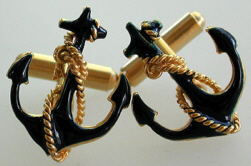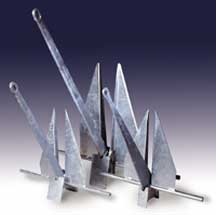
- Trade Members Only:
Please Log In to Order - Code: anchor.guide
Overview
Types of Anchors
| Admiralty Pattern Anchor (Fisherman's Anchor) This anchor is found mostly on small craft and in places where holding power is of prime importance. It consists of a shank, which carries two arms. On the arms are two flat broad parts called the flukes, which terminate in points called the pea or bill. Near the top of the shank and at right angles to the arms, a bar passes through the shank. This is the stock, which makes the anchor fall in such a position that the fluke must dig into the seabed. At approximately the middle of the stock, there is a raised metal ring or stop, which positions the stock centrally against the shank and a stock pin that goes through a hole in the stock on the other side of the shank, to lock the stock into position. With the pin removed, the stock may be slipped into a folded position for easy stowage. The top of the shank is terminated in a shackle or ring, to which the cable is attached. The gravity band is fitted at a point at which the anchor balances and a purchase tackle is attached to this point when the anchor is being hoisted inboard.  |

|
| Danforth Anchor The Danforth is amongst the best of the small boat anchors and was developed by R. S. Danforth in 1939. It produces strong holding power, because of the thin large flukes and when under a heavy strain, the flukes bury themselves very deeply. Best in sand or soft mud, but reduced or no holding in grass, rock, and clay. Instead of a stock through the head of the anchor, the Danforth has a round rod through the crown, that prevents the anchor from rolling. One of its qualities, is that it can be adapted to large and small vessels. |
| CQR Anchor (Plough Anchor) This is another popular design for small boats. It comes from England and also has no stock. It has excellent holding characteristics and rarely fouls. It penetrates sand, mud, and weed, and hooks rocks. This anchor requires adequate scope. It will dig in immediately after a 180-degree change in direction due to change in wind or tide directions on an anchored boat. |
 |
| Bruce One of the two most recent designs, it has excellent holding power in sand and rocks, but with limited holding power in soft sand and mud. This anchor will turn 360 degrees without breaking out and will right itself. However, it is awkward to stow in lockers because it doesn't fold. |
 |
| Delta The most recent design, it is similar to the CQR, but rigid. It has very high holding power/weight ratio and can be launched and recovered using a similar stem head fitting to the Bruce. |
 |
| Folding Grapnel Anchor Limited holding power, used primarily for small boats and dinghies, and reef and wreck anchoring. Easy to stow. |
 |
Which Anchor
The selection of the correct anchor or anchors for a particular boat depends on several factors - the load that the boat may place on the anchor - and the seabed. The load will also depend on external conditions such as the force of the wind on the hull above the waterline, the currents below the waterline and wake action at any give time.
The holding power of an anchor also depends on the type of bottom. An anchor that develops a 1000kg of holding power in hard sand may only be able to hold 500kg in a soft bottom. You cannot always tell in advance, where you might anchor ship, so you must have ground tackle for the most difficult anchoring you may be faced with. The horizontal force caused by a particular boat will determine anchor rode. To be effective, the rode must be long and strong enough. The length of the rode must also be so that the pull on the anchor will be horizontal. A scope of at least 7 : 1 - seven times as long as the vertical distance at high tide from the boat to the bottom. This is considered reasonably safe. For example: If you are anchoring in 5m of water, you should pay out seven times the total of 5m, or 35m of anchor rode. Any scope of less than 5m would be considered unsafe in anything but very calm weather.
A short chain between the end of the rope cable and the anchor shackle is effective in reducing shock as the chain tends to lie on the bottom, thus adding weight to the cable and maintaining the important horizontal pull. All components of the anchoring system should be joined with good quality galvanised shackles and the line should have an eye with a thimble where i
Anchoring
When anchoring consider these important points:
- Make sure the anchor line is attached to a large buoy and the boat is tied to the anchor line with a quick release mechanism. This will ensure that if you need to depart in a hurry, for example to pick up a distressed diver, you can do so quickly.
- Choose a depth where you have sufficient chain and rope to allow four times the depth at high water if using a chain only, and six times the depth if a combination of chain and rope is used. Always use the chain at the anchor end. It will help the anchor to 'dig in' and not drag. Remember to calculate the cable length required based on the depth at high water.
- Choose an area with as little tidal stream as possible. The less tide, the less hard the anchor and cable will have to work to keep you in the same position.
- Look for a sandy or muddy bottom. That will provide the best holding ground. Rocks, stones and shingle will not hold so well.
- If anchoring among other vessels, estimate the size of your swinging circle and remember that different types of boats will swing to the tide at different times, depending on the tide and the direction and strength of the wind.
- Once the anchor has reached the bottom, move slowly astern to stop the chain and/or rope forming a pile. For the best results, it is vital to lay out the cable along the bottom.
- Try lining up shore features in a transit to check whether you may be dragging your anchor. (It is important to remember that they may alter considerably if the wind or tide change direction).
- If there is any chance of snagging the anchor, rig a tripping line, but make sure the anchor buoy isn't too inviting for other craft to use as a mooring. A weight fitted on the tripping line 2-3m below the surface will keep any slackness in the line at low water, away from passing propellers.
- If you suspect that you may be dragging the anchor, let out more cable or rope. If that doesn't solve the problem, recover the anchor and try somewhere else.
- If you get snagged and cannot recover the anchor and cable, mark it with a large buoy and get some fresh divers.


























Follow us